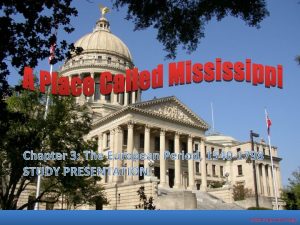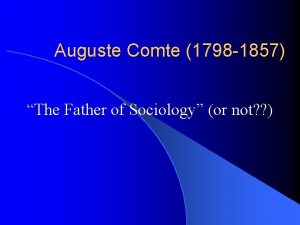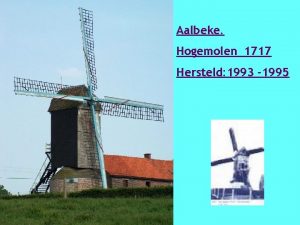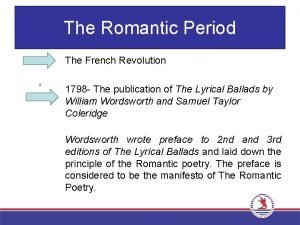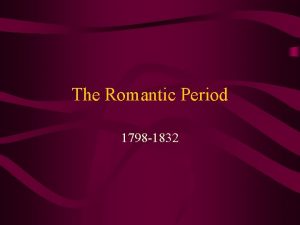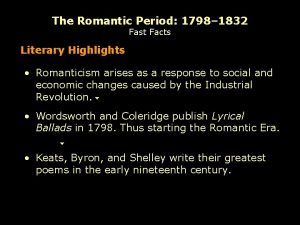Chapter 3 The European Period 1540 1798 STUDY






































- Slides: 38

Chapter 3: The European Period, 1540 -1798 STUDY PRESENTATION © 2013 Clairmont Press

Section 1: Spanish Exploration Section 2: French Exploration and the Louisiana Province, 1673 -1763 Section 3: Under British Rule, 1763 -1783 Section 4: A Spanish Province, 1783 -1798

Section 1: Spanish Exploration Ø Essential Question: How did Spain play a part in the settlement of Mississippi? 3

Section 1: Spanish Exploration Ø What terms do I need to know? • cartography • expedition • colony 4

Introduction Ø Christopher Columbus studied geography and cartography at a school in Portugal. Ø The king of Spain sent Christopher Columbus on a voyage in 1492, with three ships, crewmen, and supplies. Ø The 1492 voyage led to the settlement of the “New World. ” Portugal Spain Click for larger map. 5

Hernando de Soto’s Expedition Ø Shortly after the discovery of the New World, an expedition led by Hernando de Soto came across Mississippi land. (1540 s); landed at Tampa Bay in May 1539. Sought gold, spices, furs, etc. Ø The expedition began what is called the European period, or colonial period, of American history. Ø Spain, France, and England fought for control of the New World for two hundred years. Ø Hernando de Soto dreamed of finding riches and being wealthy; he ventured through several states, including Mississippi, on his quest. Ø Hernando de Soto died along the great river and was buried there. His body was placed on canoe and sent down the MS River. 6

The Beginning of European Rivalries Ø Europeans realized that trade and commerce with the colonies would be more profitable than looking for treasure in the New World. Ø France, Spain, and England began to establish colonies in the New World. Ø Inland settlements, as opposed to along the fringes or along the coastline, caused rivalry among colonies. Ø Rivalries eventually led to the removal of the European powers and the creation of the United States. 7

Section 2: French Exploration and the Louisiana Province, 1673 -1763 Ø Essential Question: How did France play a part in the settlement of Mississippi? 8

Section 2: French Exploration and the Louisiana Province, 1673 -1763 Ø What terms do I need to know? • casquette girl • Code Noir • Treaty of Paris of 1763 9

Introduction Ø The French became interested in finding a shortcut across the New World. Ø The French learned about the great river that “lost itself in the great sea, ” called the “Mississippi” by Indians. Ø The French realized that control of the great river was essential for trade in the New World; the river would also serve as a barrier to stop westward expansion of English colonies. France Click for larger map. 10

La Salle’s Expedition Ø The French, led by Sieur de La Salle, celebrated reaching the mouth of the Mississippi River. Ø The land tributaries along the river were named the Louisiana Province after Louis XIV. Ø La Salle planned to establish a settlement at the mouth of the river after a trip back to France, but he sailed too far west. “Louisiana” Ø The French who remained at the mouth of the river grew impatient and returned to Canada. Ø La Salle realized that he was lost and tried to find the Mississippi River again, but his rebellious crew killed him and then returned to Canada. 11

The Significance of the Mississippi River Ø France, Spain, and England saw promise in occupying the Mississippi River. Ø Each nation tried to establish a settlement at the mouth of the river, but only the French were successful. Ø The French established Natchez in 1716 and New Orleans in 1718. Ø During the span of the European period, France, Spain, and England controlled Natchez and the land that makes up modern-day Mississippi. Control of river cities meant control of river trade. 12

The Establishment of Fort Maurepas on Biloxi Bay Ø The French sent Pierre Le Monye, Sieur d’Iberville, to establish a settlement at the mouth of the Mississippi River and met Biloxi tribe. Ø Iberville and his brother Jean-Baptiste Le Moyne searched for the mouth of the Mississippi for weeks; on March 2, 1699, they thought they had found the Mississippi. Ø Uncertain as to whether or not they had found the Mississippi, Iberville went back to the Gulf Coast and built Fort Maurepas near Biloxi Bay; it served as a capital for a short time. 13

Bienville Appointed Governor Ø The capital was moved from Fort Maurepas to Fort Louis on Mobile Bay in 1701. Ø Bienville as Louisiana Governor encouraged French settlers, especially women, to come to the lower Mississippi valley; the female population of the colony was small, and Frenchmen were marrying Indian women. Also descendents became known as creole. Ø Bienville thought that a large mixed population was a threat to the peace and progress of the colony. 14

The Casquette Girls Ø In 1704, Bienville arranged for twenty young women to be brought to Fort Maurepas and married to Frenchmen. Ø The young women did not adjust well to their new conditions, and they vowed to return to France; however, the French captains would not allow their passage back. Ø The young women were called casquette girls because each was given a casquette, or small suitcase, with a wedding dress and other personal articles. Many came from orphanages in France and sent with little clothes and belongings and were married off once here. Some marriages did not work out. https: //www. bing. com/videos/search? q=undertaker+sound+audio&& view=detail&mid=5 F 98 D 6 FEF 4 C 5 C 0657447& &FORM=VDRVRV 15

Fort Rosalie Ø Bienville wanted to make trade and commerce on the lower Mississippi River safe from Indian attacks. Ø He led a group of soldiers against the Natchez Indians but eventually negotiated with them. Ø The Natchez Indians provided materials to create Fort Rosalie, which became a center for French activity. 16

The Development of the French Natchez District Ø After Fort Rosalie was established, the prosperity and the population of the Louisiana Province, especially the lower Mississippi valley, increased. Ø New Orleans was capital of Louisiana Province. Ø The Louisiana Province was separated from the French colony in Canada and was divided into nine districts, three of which later became the state of Mississippi: Biloxi, Yazoo, and Natchez. 17

New France 1750 18

The Code Noir Ø The French under Bienville who moved to Louisiana from the Caribbean brought their slaves with them & set up laws known as the Code Noir in 1724 which were not as strict as slave codes passed in other areas. The Code Noir governed slavery in the French colonies. 19

The Removal of the French from the Mississippi Valley Ø The Natchez Indians liked the French when they were traders and trappers but took issue when they claimed private land ownership and established large plantations. Ø The French also had problems with the English who were moving westward and claiming land; the overlapping claims led to war among France, Spain, and England. Ø The French and Indian War lasted from 1754 -1763; it was settled by the Treaty of Paris in 1763. Indians upset over European land claims to North America. Ø The Treaty of Paris forced France to give up its land in North America east of the Mississippi River to England, and Spain got the French land west of the Mississippi River. 20

Section 3: Under British Rule, 17631783 Ø Essential Question: How did Great Britain affect the development of Mississippi? 21

Section 3: Under British Rule, 17631783 Ø What terms do I need to know? • • • Proclamation of 1763 31° parallel 32° 28’ parallel firewater confluence indigo Continental Congress Loyalist Treaty of Paris of 1783 22

Introduction Ø The Treaty of Paris of 1763 officially gave Mississippi land to England. Ø The English realized that governing their new, vast land might be difficult. Ø In order to give themselves time to work out an agreement with the major Indian nations, the English government issued the Proclamation of 1763; it stopped some unwanted migration west, temporarily, and was meant to keep Native Americans and white settlers from fighting over land. 23

British West Florida Ø In 1763, the English government divided the former Spanish Florida into British West Florida and British East Florida; British West Florida included part of the land that became the state of Mississippi. Ø The original boundaries of British West Florida were at a 31° parallel north. Ø Once the British realized that Fort Rosalie (Natchez) was north of the 31° parallel, they moved the parallel up to the 32° 28’ parallel, and it was renamed Fort Panmure. 24

British Indian Policy Ø The British held an Indian Congress at Mobile which was attended by many Southeast Indian leaders. Ø The conference was meant to reach a peaceful agreement between white settlers and Native Americans; it resulted in pledges of friendship and trade agreements. Ø As a result of the conference, many Indian nations gave large amounts of land to the British.

Development of the British Natchez District Ø As the population of British West Florida increased, the colony was divided into four districts. Ø One district created was the Natchez District. Ø The Natchez District included the area from the flowing together of the Yazoo and Mississippi Rivers. Ø Former British officers were given thousands of acres of land grants in the Natchez District. Ø The settlers of the Natchez District grew tobacco, cotton, corn, and indigo.

Natchez during the American Revolution Ø The thirteen American colonies declared their independence from England in 1776. Ø After independence, the Natchez District remained loyal to the British. Ø Most of the prominent citizens in Natchez were former British soldiers and did not support the American Revolution. Ø William Dunbar, a distinguished citizen in Natchez, introduced science instruments and knowledge to the area. Ø Natchez was important to the American colonies because of its strategic location/cotton crop as export.

Natchez during the American Revolution: The Willing Expedition Ø The Continental Congress sent James Willing, a former Natchez resident, on an expedition to encourage Natchez citizens to join the American cause. Ø When Willing arrived in Natchez on February 21, 1778, he found that many Natchez were Loyalists and arrested several of them, took some of their property, and took some prisoner. Ø Willing was ordered to leave the city and take his English captives with him; the Spanish feared a war with the English. (he was ready and willing!)

Natchez during the American Revolution: Spain Declares War on England Ø The American Revolution kept the English on the Atlantic coast and vulnerable to a Spanish attack along the Gulf Coast. Ø Spain declared war on Great Britain in 1779. Ø Spain had reoccupied most of Florida within two years of the war. 29

Natchez during the American Revolution: Natchez Revolt Ø The British citizens at Natchez did not acknowledge Spanish reoccupation of Florida. Ø The Natchez residents recaptured Fort Panmure on April 22, 1781, but the Spanish regained the fort on July 23, 1781. 30

Natchez during the American Revolution: Treaty of Paris of 1783 Ø Under the Treaty of Paris of 1783, the American colonies were recognized as independent, the United States of America. Ø The British gained control of land west of the Mississippi River according the treaty. Ø The boundary line between America and Spanish Florida was not clearly settled by the treaty.

32

Section 4: A Spanish Province, 1783 -1798 Ø Essential Question: What effects did Spanish rule have on the people of Mississippi? 33

Section 4: A Spanish Province, 1783 -1798 Ø What terms do I need to know? • militia • Treaty of San Lorenzo • right of deposit 34

Spanish Era II: 1783 -1798 Ø The Natchez District experienced growth and prosperity under Spanish control. Ø Spain was a Catholic nation, but Jews and Protestants were guaranteed religious freedom by the Spanish government. Most spoke English. Ø Code Noir had been applied by French but Spanish were not as forceful with that idea. Ø Colony was ruled by Governor Gayoso who was fair and wise. Rebuilt Fort Nogales upriver from Natchez in 1795. 35

Population Increase Ø Population growth in the Natchez District kept up with economic development as cotton culture increased. The Spanish encouraged settlers to bring their slaves to the Natchez District; additional land grants were given to slave owners. Ø Slave revolt in 1795; rumors persisted; some were killed for trying to escape; settlers feared crop could fail and ruin the economy. 36

America Acquires Mississippi Ø In 1795, the Spanish gave up their claim to land north of the 31° parallel. Ø Under the Treaty of San Lorenzo in 1795, Americans were given free navigation of the Mississippi River, and they were given the right of deposit in New Orleans. Ø Spanish authorities did not want to leave Natchez but had no reason to stay; Mississippi became an American possession; leading cotton producer. 37

Image Credits Slide 1: allstarecho on Wikimedia Commons; Slide 2, 18, 19, 32: Public Domain Wikimedia Commons; Image Credits slide: Eskimo. the on Wikimedia Commons Return to Main Menu 38
 Chapter 3 the european period answers
Chapter 3 the european period answers The romantic period 1798 to 1832 summary
The romantic period 1798 to 1832 summary The romantic period 1798 to 1832
The romantic period 1798 to 1832 The romantic period 1798 to 1832 summary
The romantic period 1798 to 1832 summary Romantic age starts from
Romantic age starts from The romantic age (1798 to 1824)
The romantic age (1798 to 1824) Mil-std-1540
Mil-std-1540 Guinness the 1798 limited edition
Guinness the 1798 limited edition Consensus universalis comte
Consensus universalis comte How has the us changed from 1798 to 1898
How has the us changed from 1798 to 1898 The romantic age (1798 to 1824)
The romantic age (1798 to 1824) Rumford teplo
Rumford teplo Landergemmolen
Landergemmolen 1798 in english literature
1798 in english literature The development of children 7th edition
The development of children 7th edition A&p flix activity: resting membrane potential
A&p flix activity: resting membrane potential When is the relative refractory period
When is the relative refractory period Critical period vs sensitive period
Critical period vs sensitive period Critical period vs sensitive period
Critical period vs sensitive period Approaches to child development
Approaches to child development Less complicated texture than baroque (more homophonic)
Less complicated texture than baroque (more homophonic) 51 neutrons period 5
51 neutrons period 5 Period of activism 1970-1972
Period of activism 1970-1972 Stability period vs measurement period
Stability period vs measurement period Trustee period and royal period
Trustee period and royal period Written records in history
Written records in history European study group with industry
European study group with industry Hình ảnh bộ gõ cơ thể búng tay
Hình ảnh bộ gõ cơ thể búng tay Lp html
Lp html Bổ thể
Bổ thể Tỉ lệ cơ thể trẻ em
Tỉ lệ cơ thể trẻ em Voi kéo gỗ như thế nào
Voi kéo gỗ như thế nào Tư thế worm breton là gì
Tư thế worm breton là gì Alleluia hat len nguoi oi
Alleluia hat len nguoi oi Môn thể thao bắt đầu bằng chữ đua
Môn thể thao bắt đầu bằng chữ đua Thế nào là hệ số cao nhất
Thế nào là hệ số cao nhất Các châu lục và đại dương trên thế giới
Các châu lục và đại dương trên thế giới Công thức tiính động năng
Công thức tiính động năng Trời xanh đây là của chúng ta thể thơ
Trời xanh đây là của chúng ta thể thơ
